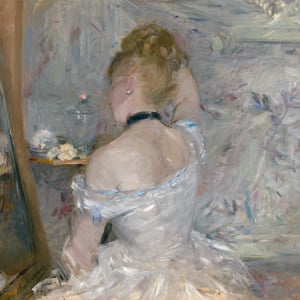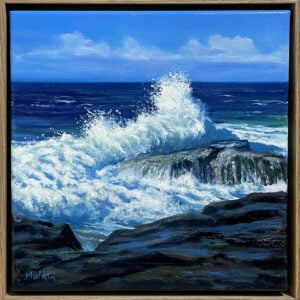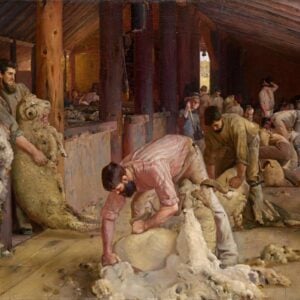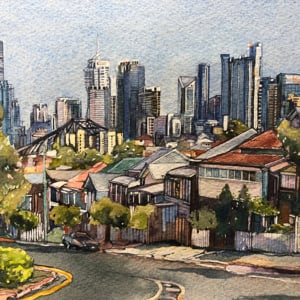I don’t write about Alfred Sisley as much as I should. Despite being one of the figureheads of Impressionism, he is overshadowed by some of his more famous contemporaries, such as Claude Monet and Pierre-Auguste Renoir. In light of this, I wrote this post about Sisley’s life and art. In this post, I cover:
- Key Facts About Alfred Sisley
- A Closer Look at Alfred Sisley’s Paintings
- Quotes by Alfred Sisley
- Thanks for Reading!
“Every picture shows a spot with which the artist has fallen in love.” Alfred Sisley

(Before diving into this post, make sure to pick up a copy of my free Landscape Painting Starter Kit.)
Key Facts About Alfred Sisley
Here are some of the key facts about Alfred Sisley:
- He was born in France to a wealthy British family. His early art career was supported by his father, who was in the silk business.
- He moved to London in 1857 to study business but quit and moved back to Paris after four years.
- He began his formal art studies in 1862 when he enrolled in the atelier of Charles Gleyre, a skilled artist and teacher. It was there he met Monet, Renoir, and many other now-famous artists who also studied under Gleyre. Below is a portrait by Renoir featuring Sisley during his early days as an artist (I was unable to find any of Sisley’s student works, unfortunately).

- He received an allowance during the 1860s from his father to support his art, putting him in a much better position than many of his contemporaries.
- In 1868, his Avenue of Chestnut Trees Near La Celle-Saint-Cloud was accepted to the Salon exhibition in Paris. His work was rejected from the Salon in 1867 and 1879.

- In 1870, the Franco-Prussian War ruined his father’s business and forced Sisley to support himself from his own art sales. He spent the rest of his life as a poor man, as his art was not really appreciated until after his death (as is the case with many artists sadly).
- He applied for French citizenship twice but was rejected the first time and illness intervened the second time. This may explain his lack of success during his lifetime. Being a British citizen born in France, he was torn between two cultures, unable to establish himself firmly within either. This reminds me of the Australian Impressionist, John Russell, who spent most of his time painting in France but was not fully embraced by their culture like other Impressionists.
- He died on 29 January 1899 of throat cancer at the age of 59. During his lifetime, he created around 900 oil paintings, 100 pastels, and many drawings.
A Closer Look at Alfred Sisley’s Paintings
Sisley painted mostly calm landscapes in a typical Impressionist style, with simple forms, broken color, and a colorful palette. His work is similar to that of Monet, but his use of color was much more restrained.

In some cases, Sisley was too restrained in his use of color. The foggy depiction below, whilst perhaps accurate, is not much to look at in my opinion.

I prefer when Sisley pushed the color a bit more, like in the painting below. There is a strong feeling of light in this painting as a result of:
- Near-white highlights used for the clouds;
- Value contrast between the lights and darks. The stronger the contrast, the stronger the light source appears; and
- Temperature contrast between the lights (warm) and darks (cool).

The Moret Bridge, Storm Effect is a dramatic painting with rich, distinct colors and energetic brushwork. The dark colors used for the buildings and bridge contrast against the bright clouds. On the bridge, you can see two people making their way across, painted with nothing but a few strokes of black.
The water is picking up all kinds of reflections: the highlights from the clouds, the blue of the sky, the grays and blues of the building. The regular brushwork creates a sense of movement in the water. Also, notice the white highlights scumbled across the top of the water to indicate whitewater. This is a simple but effective technique which gives the water a sense of realism. Without these highlights, it might be difficult to tell where the water ends and the land starts.

Outside of pleasant, sweeping landscapes, Sisley also painted rigid architecture from time to time, like Church in Moret (below). Here are a few of my observations about the painting:
- It is a great demonstration of how light and shadow affect the colors we see. The building itself has a near-white or light gray local color, but under the warm light of the sun, it appears bright orange. In shadow, it appears like a dull purple.
- There is a pleasing contrast between warm lights and cool shadows.
- Although Sisley painted with rough brushwork, his drawing was still very accurate.
- The use of hard, lost, and soft edges is incredibly important for conveying a sense of realism about the building. Hard edges suggest an abrupt change, from light to dark, or from the building to the sky. Soft edges suggest a gradual or subtle change, like the transition between two planes of the building which are both hit by light. Lost edges suggest the whole area is in shadow or hit by a bright light.

I indicate some of the different hard, soft, and lost edges below.

Sisley was fairly restrained with his use of color in The Bridge at Moret at Sunset (many of the other Impressionists really pushed the colors in their sunset paintings).
The sky is made up of a pleasant contrast between rich purples and light yellows and blues. Sisley used broken colors to depict the water, which is reflecting the dark shadows and the colorful sky. This type of brushwork contrasts against the solid brushwork used for the architecture.

In Footbridge at Argenteuil, notice the lack of rendering Sisley used for the people; nothing but simple color shapes. But, the right colors and shapes in the right places can convey a significant amount of information about the subject, even without any of the finer details.
This painting is also a great demonstration of linear perspective. Notice how all the lines used for the footbridge converge towards a vanishing point in the distance.

The painting below reminds me of Monet’s haystacks series. Haystacks were a popular subject with the Impressionists, probably because they were so effective at demonstrating light and shadow.

The Lane of Poplars at Moret is an interesting play between positive and negative space. The positive space being the trees and the negative space being the sky, clouds, and houses in the background.
Interestingly, this painting has been stolen on three separate occasions, most recently from the Musée des Beaux-Arts in 2007.

I love in the painting below how the woman resting along the stream almost blends in with the rest of nature. Also, notice how the woman’s dress still appears white, despite no white being used to paint it.
This is an example of an analogous color scheme, which utilizes colors positioned close to each other on the color wheel (in this case, greens and blues). It is a calm and low-contrast color scheme favored by the Impressionists.
Sisley also made clever use of outlining to give form to some of the main trees which line the stream.

Below are two winter paintings by Sisley. His restrained use of color was perfect for depicting these snowy landscapes.


Quotes by Alfred Sisley
On depicting emotions:
“Though the artist must remain master of his craft, the surface, at times raised to the highest pitch of loveliness, should transmit to the beholder the sensation which possessed the artist.”
On creating movement:
“The animation of the canvas is one of the hardest problems of painting.”
On nature:
“I like all those painters who loved and had a strong feeling for nature.”
On process:
“I always start a painting with the sky.”

Thanks for Reading!
Thanks for taking the time to read this post. I appreciate it! Feel free to share with friends. Want to learn more about landscape painting? Check out my Landscape Painting Masterclass.
Happy painting!

Dan Scott







Thank you! I wasn’t very familiar with Sisley.
Thank you Dan for your articles on Sisley, love the collection of paintings.
Being a fairly new painter, love every article you post. Thanks
Sisley depicts the essence of snow or water or sky. Upon seeing the winter scene in Vienna my instant response was to grab a warm coat. Tragedy he got lost in the cracks.
This was delightful! Thank you
Lovely selection of paintings so fresh and colourful. Thank you
Thank you.
I appreciate your articles about impressionist painters very much.
Thank you for your important lessons
I’m improving my paintings by following your teachings, thank you! Sisley was as good as Monet in my opinion. Sadly, even in art there are cultural politics.
Thank you very much! I look forward to your emails!
I want to Thank You personally for your introduction to artists I am not familiar with and also a big thank you for detailing their styles! You are so kind!!!!
Thank you. I love his works. They have details that I stop every time.
I love everything you share! I like how you included examples of values, contrast, color also style! I hope to see more!
I’ve never heard of Sisley before, but his paintings are very inspiring. Thank you for presenting his work.
I love these paintings thank you very much. I was not familiar with him.
Thank you your articles really cast a great perception of the artist work. Keep it up. I appreciate your articles.
Thank you! I really enjoy seeing the paintings and your comments.
So interesting! You always give me so much to think about. Thank you thank you thank you!
Sisley is one of my favorite painters. Thank you for your comments and selection of paintings.
I was a docent at the McNay Art museum in San Antonio where they had two of Sisley’s landscapes. I always stopped there on my tours as they were interesting in the beginnings of the Impressionist’s movement.
Your comments are excellent; I wish I had them when I presented those two paintings to the visitors on the tour. Thanks!
Hi Dan,
I guess, when it comes down to it, art is just another profession where you can be great at what you do but aren’t apprececiated by those who can make or break you.
I think this man was a great artist, but he fits into this category.
I, for one, think his work is wonderful. I would love to see more of his art if you could manage it in the future, or maybe put me onto a site where I could see it.
Thanks Dan, keep ’em coming,
Dave M ???
I enjoy your analysis and showing of the points you make i.e. hard, soft, lost edges for example
I really enjoy and look forward to your posts. I find this one interesting from several points. First Sisley tells us how personally invested every artist is in each painting. What and where is the investment in Fog? Just about every element leads back to the center of interest… the back fence. Perhaps feeling closed in expressed in the fog and fences? Why was Monet’s Vetheuil in the Fog (1879) so much better and more accepted? Cursed by the curious gene this was a great article for me. Thanks
Thanks Dan for showcasing Arthur Sisley’s work. I must confess I had not heard of him before but I like his work very much. Regards.
amazing artist…variation and veracity!
Many thanks for your article. Interesting comparison with J. Russell. Far back I bought a frame Print of one of his painting .
Serge
I love the works you are exposing us to and your informative commentary.
I just love how you present the material with such simplicity, but enough detail for me to want to explore further.
Thanks Dan. Love, love Alfred Sisley! I painted three of his works and absorbed much.
I’d love to take your landscape class…if I could just send a check!
P. T.??
Sisley’s use of colour is so interesting, so much green in the snow scenes! Thankyou Dan for a very informative observation.
Hi Dan, I like this educational explanations of all famous artist’s paintings. Thank you so much. It reminds me all sorts of valuable points time to time. However, I take time to read due to other schedules . But these lessons are highly appreciated.
Thank you for your interesting and appreciative article on the work by Sisley. As for “Fog, Voisins”, I’m glad you displayed it despite it not being a favorite of yours. I enjoyed its excellent use of atmospheric perspective and subtle shifts in color and value, and I think it successfully portrays the dense quality of air on a foggy day. It also shows more of Sisley’s range. Thanks again.
Dear Dan,
Thankyou for your informative, instructive posts.
I thought I had kept them all but can’t find he one focusing on John Singer Sargent’, “Madame …..” which I would love to read again (and again). Would you be so kind as to send it tome again, please Dan?
That’d be much appreciated.
Yours sincerely,
Teresa
Hi Teresa.
Thanks for your comment. Certainly, no problem. I will email you the link to the other post today.
Thanks.
Thanks, Dan.
I hope that works. It was a great learning experience for me, although I don’t paint.
Just have a passion about art history and how artists achieve their aims, so thanks again.
Yours sincerely,
Teresa
I found your article very interesting, Dan.
I recently moved to Marly-le-Roi, just north of Versailles, where Sisley spent a lot of time and did a lot of painting. The town has done a great job marking out points of interest in its illustrious history, including putting up panels showing reproductions of paintings by Impressionists such as Sisley. Just today I stood on the spot where he painted his L’Abreuvoir de Marly, Gelee Blanche in 1876.
It was interesting to learn more about Sisley through your article. Thanks
If Sisley were to read your post, I feel he would be very pleased. I know that I was moved by your presentation of his works
Thanks, Dan. Sisley is one of my favorite painters. Folks might be interested in knowing that Sisley was the only impressionist who consistently painted alla prima. Monet, for example, painted in many layers. As an aside, has anyone noticed that it appears Sisley employed an ochre imprimatura instead of a white canvas?
This is a wonderful article! Here’s what Camille Pissarro, who acted as a father and great supporter of the Impressionists said about Alfred Sisley: All the four who founded Impressionism (Monet, Renoir, Bazille, and Sisley) are great painters. But there is only one true master among them and that is Sisley.
Some art critics and art historians rank Alfred Sisley as one of the top landscape painters of all time.
I absolutely love Sisley’s work. His treatment of landscapes incorporates a lot of Realism and Impressionism together. And his village scenes are downright enchanting. I look at them and want to move to Louveciennes in the 1880s.
Dan, I wasn’t familiar with Sisley until you brought it up. I enjoyed your analysis /comments on his paintings. Sisley is now one of my Impressionists painters together with Monet and Renoir.